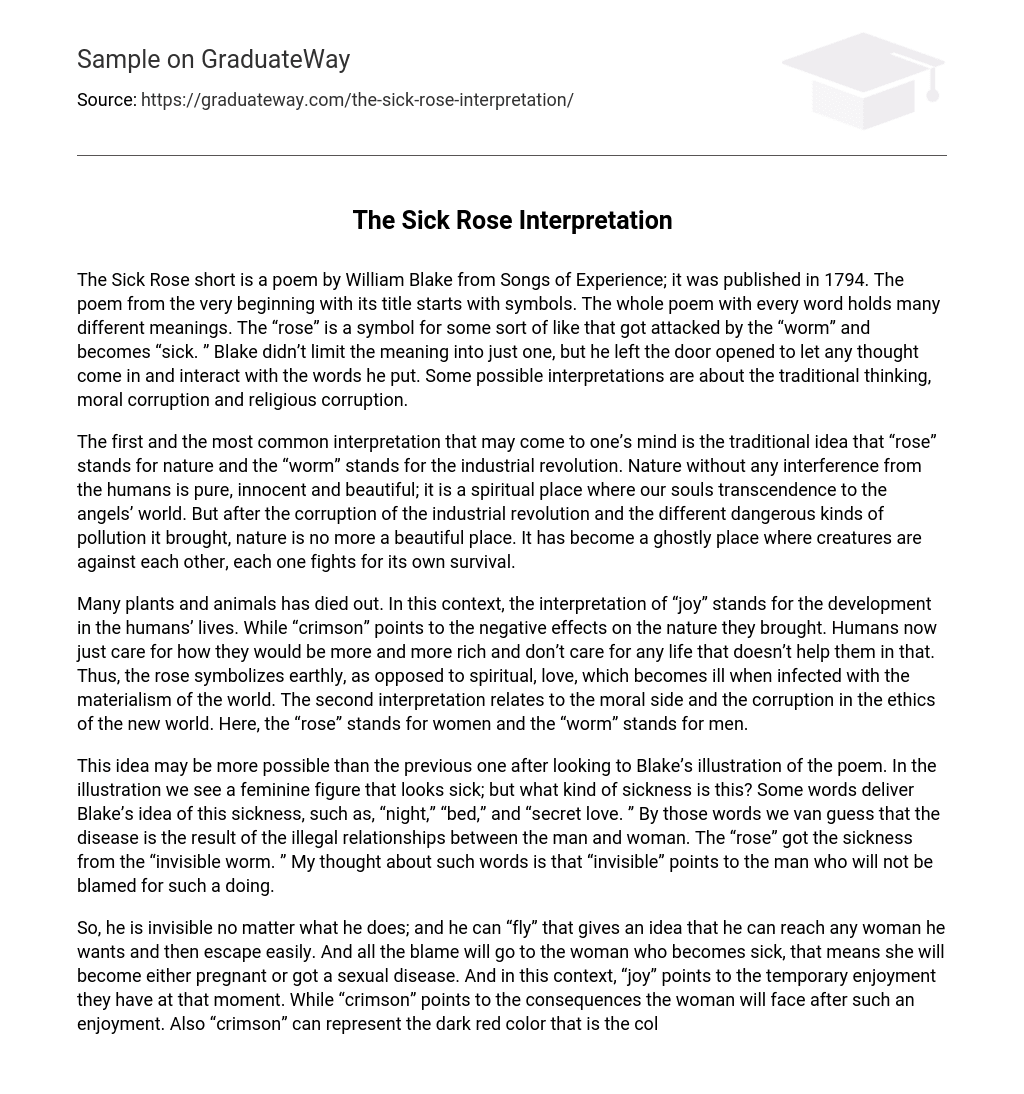The Sick Rose, published in 1794, is a poem by William Blake from the collection Songs of Experience. It delves into multiple layers of symbolism, starting from its title to every word it contains. The “rose” represents a life form that has been afflicted by a “worm,” resulting in illness. Rather than providing a definitive interpretation, Blake purposefully leaves room for individual contemplation and encourages various possible explanations such as critique of conventional beliefs, moral degradation, or religious misconduct.
The initial and most prevalent interpretation is the conventional notion that the term “rose” symbolizes nature, while the term “worm” represents the industrial revolution. Nature in its unaltered state, free from human intervention, is pure, innocent, and captivating; it serves as a spiritual realm where our souls ascend to an angelic dimension. However, with the corrupting influence of the industrial revolution and the various hazardous types of pollution it introduced, nature has lost its beauty. It has transformed into a haunting realm where creatures are pitted against each other, each struggling to ensure its own survival.
The extinction of many plants and animals signifies the advancement of humans’ lives, with “joy” representing this progress and “crimson” representing the detrimental impact on nature. Human priorities have shifted to the pursuit of wealth, disregarding any life that does not contribute to their riches. As a result, the rose symbolizes worldly love tainted by materialism. Another interpretation relates to the decline in moral values and ethics in society, with the “rose” representing women and the “worm” representing men.
Upon analyzing Blake’s illustration of the poem, it appears that this concept may be more attainable than the previous one. The depiction portrays a frail feminine figure, but what kind of ailment does she suffer from? Blake’s use of language, including “night,” “bed,” and “secret love,” offers insight into the nature of her malady. Based on these terms, we can deduce that the affliction stems from illicit relationships between a man and a woman. The sickness was contracted by the “rose” through an “invisible worm.” In my interpretation, the term “invisible” suggests that the man will evade responsibility for his actions.
Irrespective of his actions, he remains unseen. He has the power to “soar,” indicating that he can effortlessly chase after any woman he desires and escape capture. Ultimately, the woman who becomes a target for him will be held responsible, whether it is due to pregnancy or acquiring a sexually transmitted disease. Within this framework, “happiness” denotes the brief satisfaction they feel in that instance, while “crimson” represents the consequences the woman will suffer later on. Furthermore, “crimson” may also symbolize the dark red hue of tainted blood. Lastly, let us contemplate the religious perspective.
In the beginning of creation, humans disobeyed God in their previous life and were subsequently sent to earth. This fact leads to the following interpretation: the “worm” symbolizes the satanic thinking that influenced the “rose,” representing humanity. The term “crimson” refers to the suffering experienced by humans in earthly life after indulging in pleasure without considering the consequences. On the other hand, the “rose” could represent Christianity, while the “worm” symbolizes hypocritical clergymen who live luxuriously while others endure a difficult existence.
Thus, this interpretation is centered around the religious corruption that originated from eternity and has resurfaced in the present lifestyle. Ultimately, the unique understanding of such a symbolic poem is shaped by our daily experiences and how we perceive the world. Consequently, numerous diverse interpretations will arise, and it would be incorrect to deem them as erroneous. Each interpretation possesses its own distinctiveness, reflecting the inner thoughts of the individual who articulated it. Blake liberates our imagination without any restrictions and eagerly awaits our reflections. Nevertheless, he does not disclose his secret, allowing each person to be creative in their unparalleled manner.





